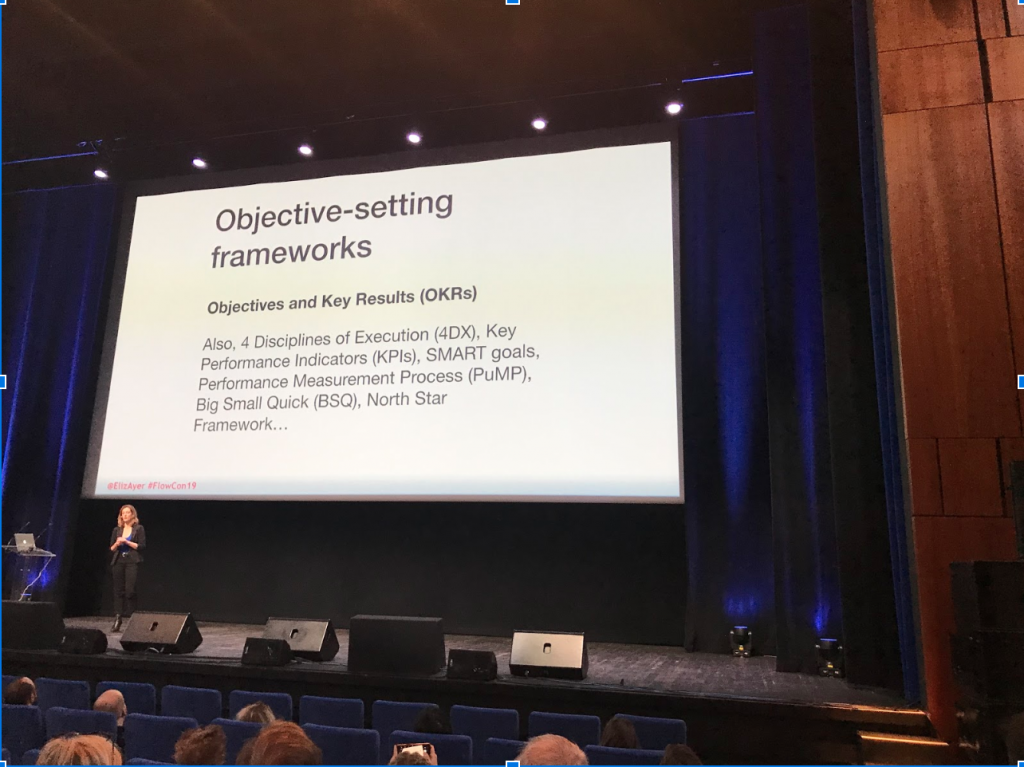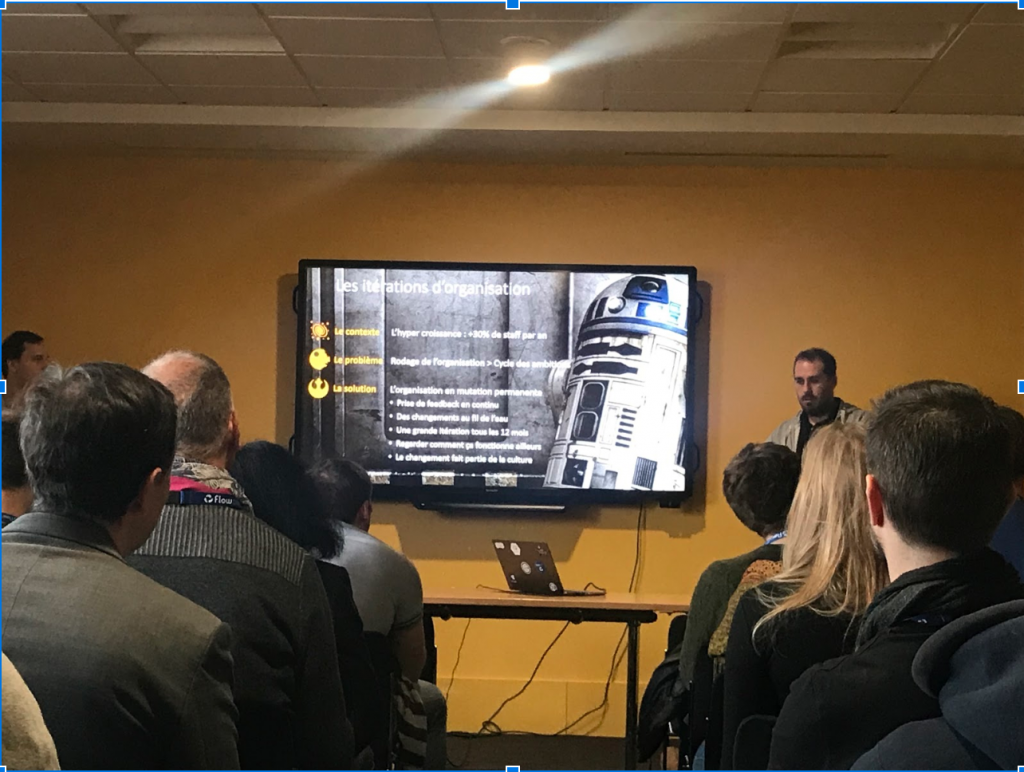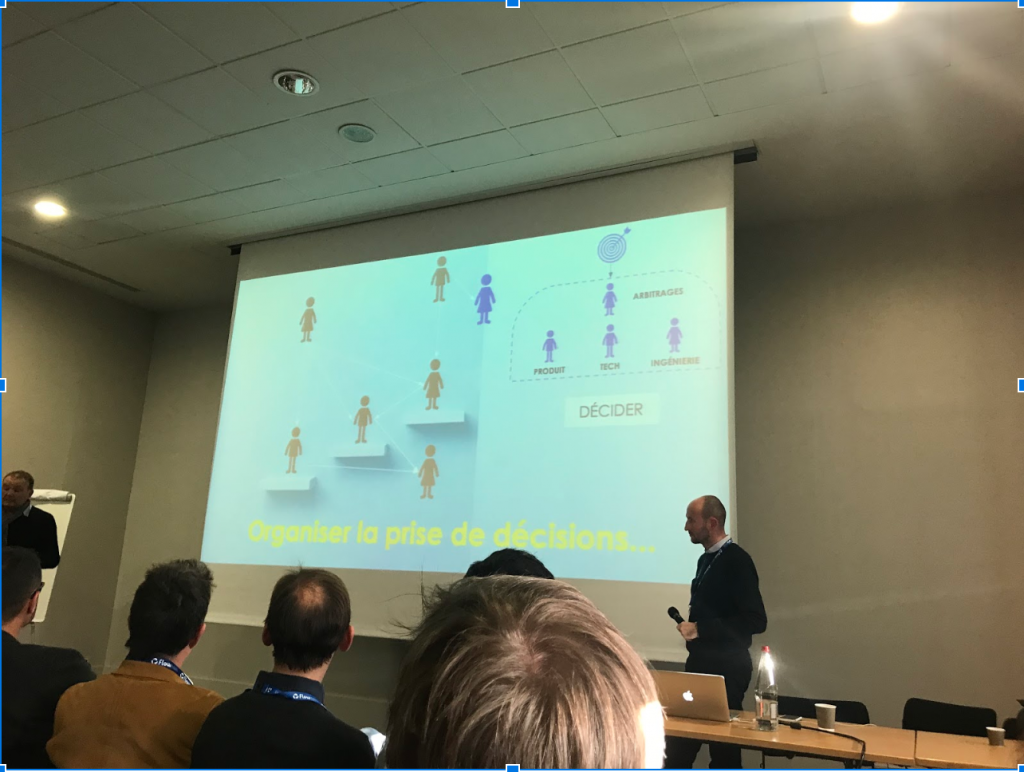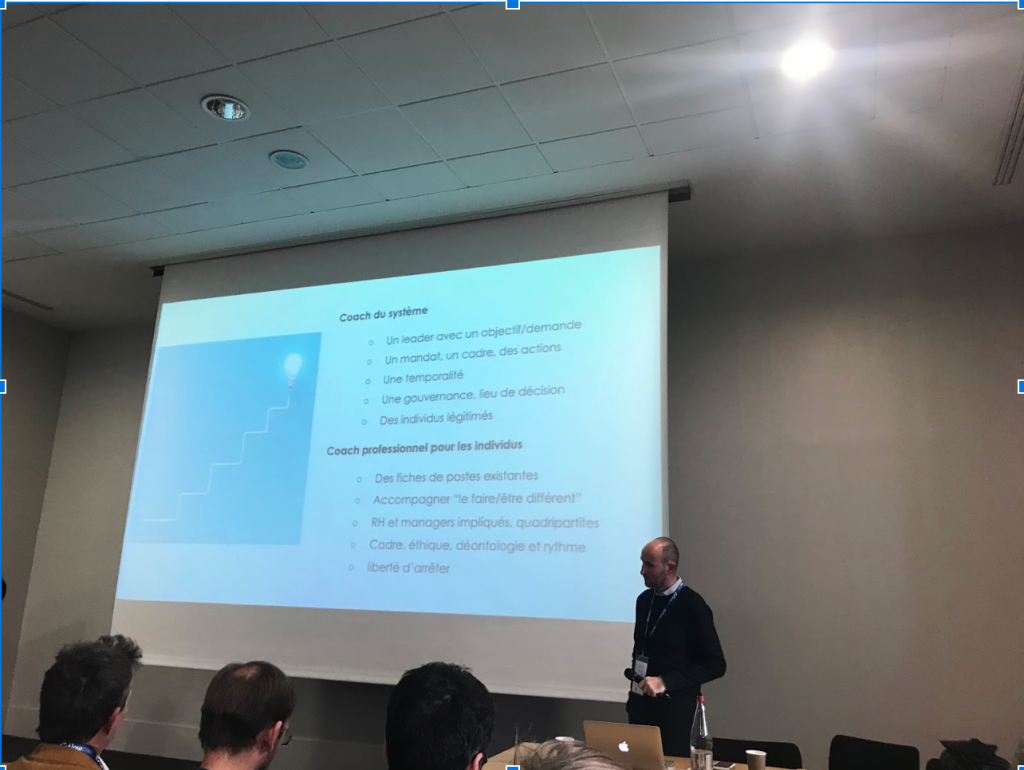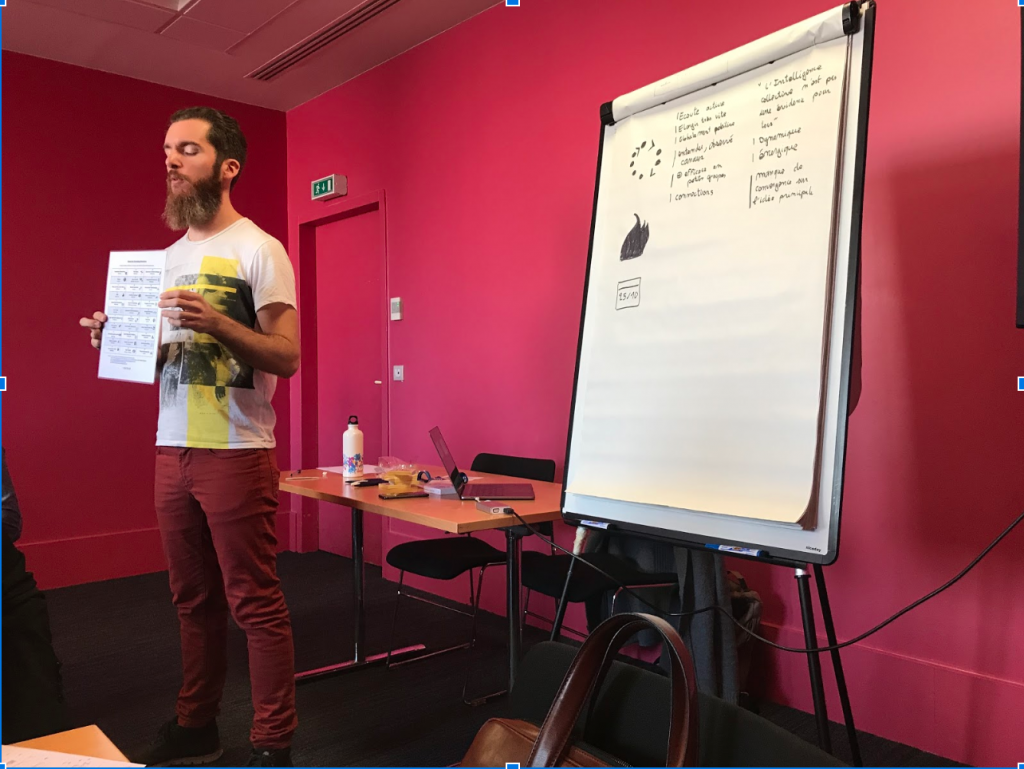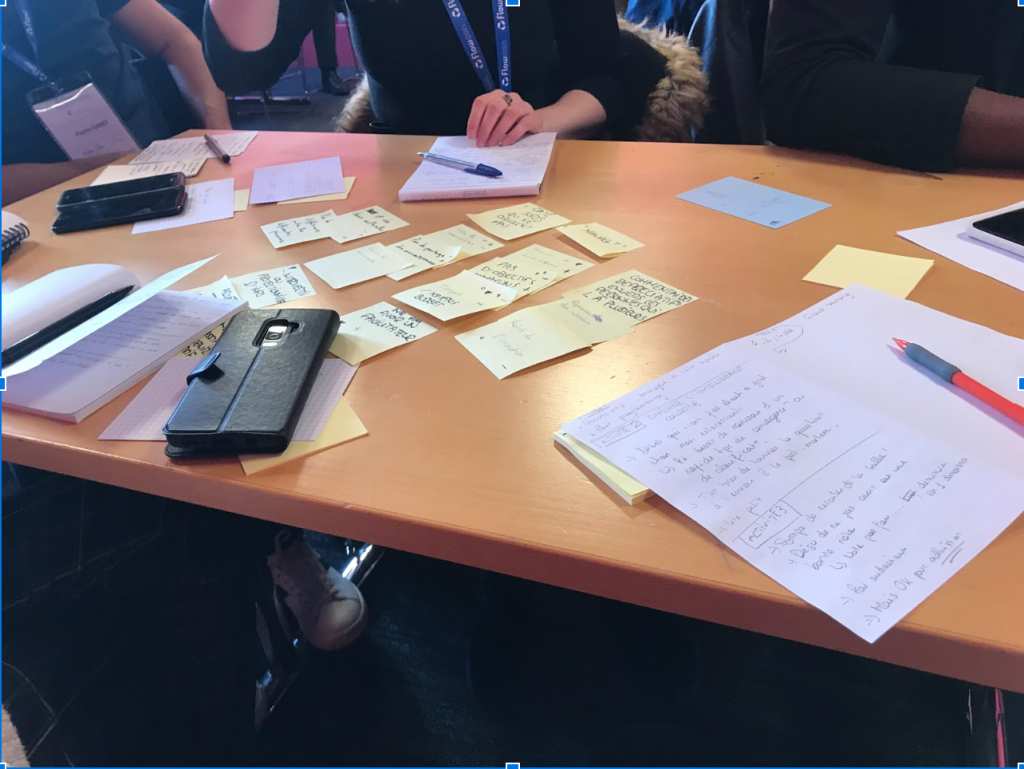The FlowCon is a conference on flow software development that mixes Kanban, Lean, Product, UX, DDD, Continuous Delivery, DevOps or Business Agility. It took place in Montrouge (near Paris) on December 12 and 13 and I was invited there to talk aboutpragmatic UX design. I take this opportunity to tell you about the workshop and the conferences that marked me.
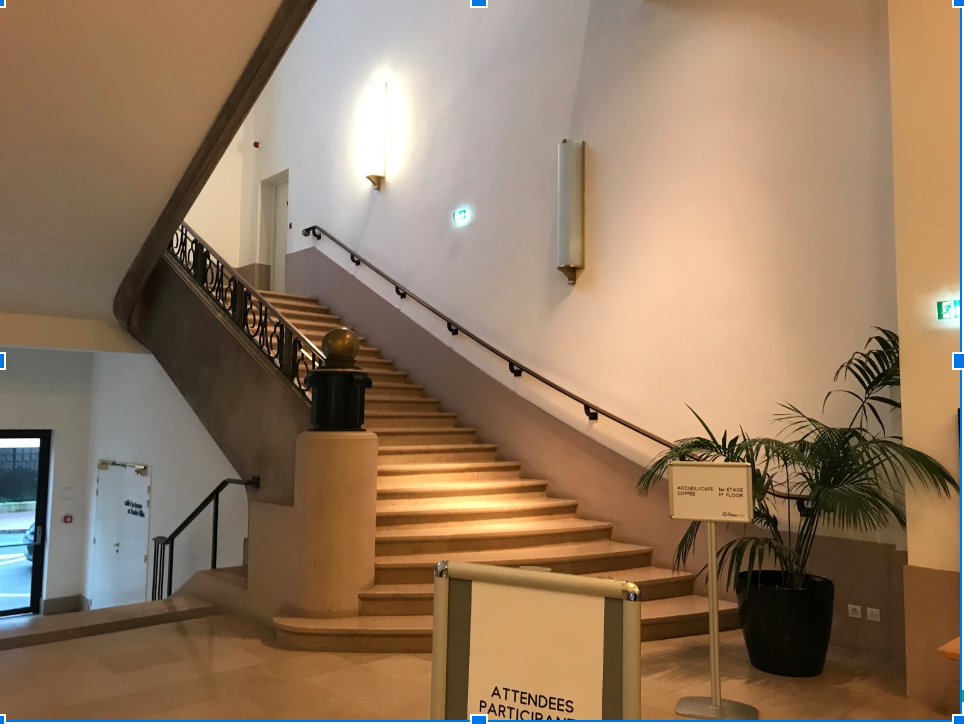
#1 Keynote: Product Management for Continuous Delivery – Elizabeth Ayer
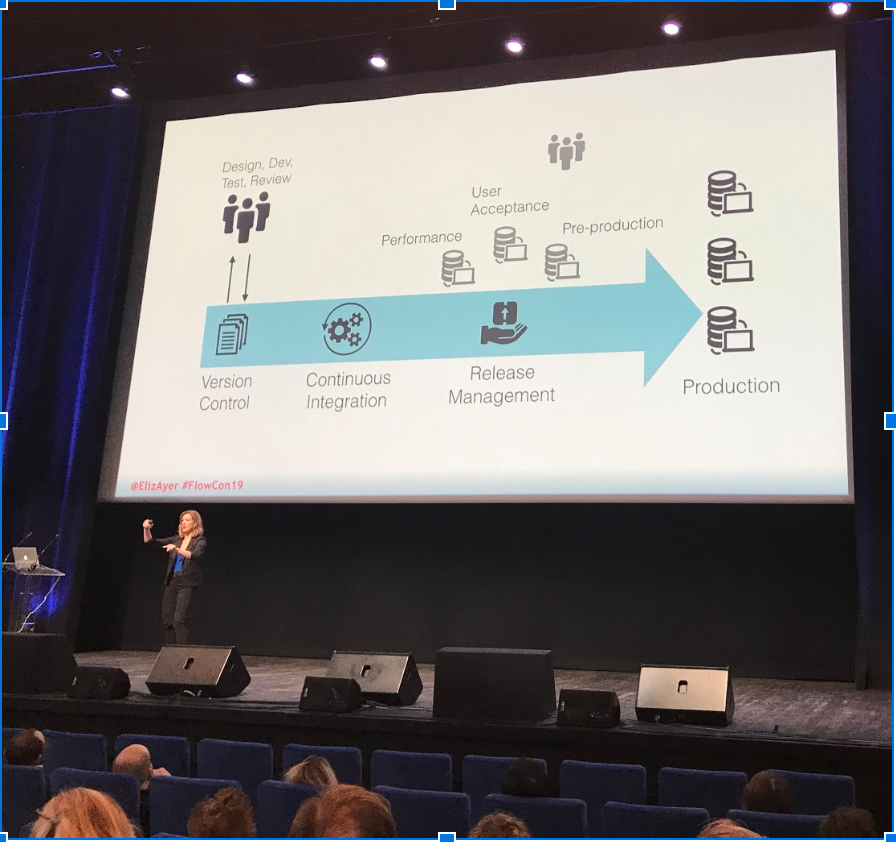
During the keynote, elizabeth ayer mentioned a number of key elements of digital product management such as theimportance of experimentation.
Through the story of museum about David Kirkaldy and how this man spread the culture of experimentation, in particular thanks to the tests carried out on “sample” trains to avoid large-scale disasters, elizabeth ayer reminds us that systems (mainly meaning organizations or businesses) change gradually by observing the success of others.
Some start with the nice speeches, without carrying out the actions, but starting with the good speech is already a first step towards the good deed.
She also raised the subject of the “black hole” post-delivery of a digital product in agile. Once the product is delivered to customers or users, the team that worked on it has absolutely no interest in it.
Elizabeth emphasizes the importance of not falling into this trap by creating a loop to collect user feedback (“user feedback”).
During this keynote we also saw or reviewed the following tools for communicate or track goals of an organization, company, team, etc. :
- 4DX
- KPIs
- Pump
- bsq
- North Star framework
She also spoke about the “continuous delivery” or continuous delivery. The speaker alerted us to the fact that the fluidity and speed of the development team brings back the bottleneck on the product team side, which must be more reactive to try to adapt to the rhythm.
Finally, she gave us key elements for theteam autonomy.
According to her, this is based on :
- technical skill,
- a clearly defined scope.
It was an effective Keynote to cover a number of key topics on managing a digital product.
#2 Start up, scale up, screw up – Jurgen Appelo
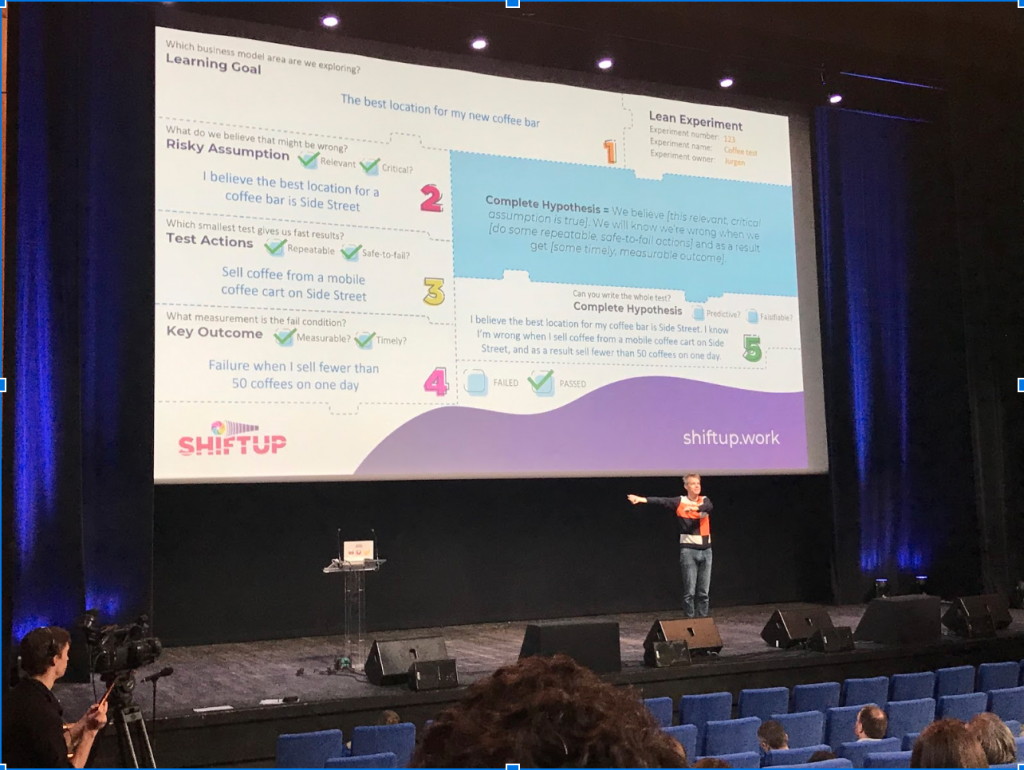
Jurgen Appelo, notably famous for the theorizing of “management 3.0”, shared with us the reflections transcribed in his latest book: START-UP, SCALE-UP, SCREW-UP.
He reminds us that designing and making a product is not linear, it is moreover for him rather a “vortex” in which you have to go through product management, design thinking, lean startup, UX design activities in a somewhat chaotic way.
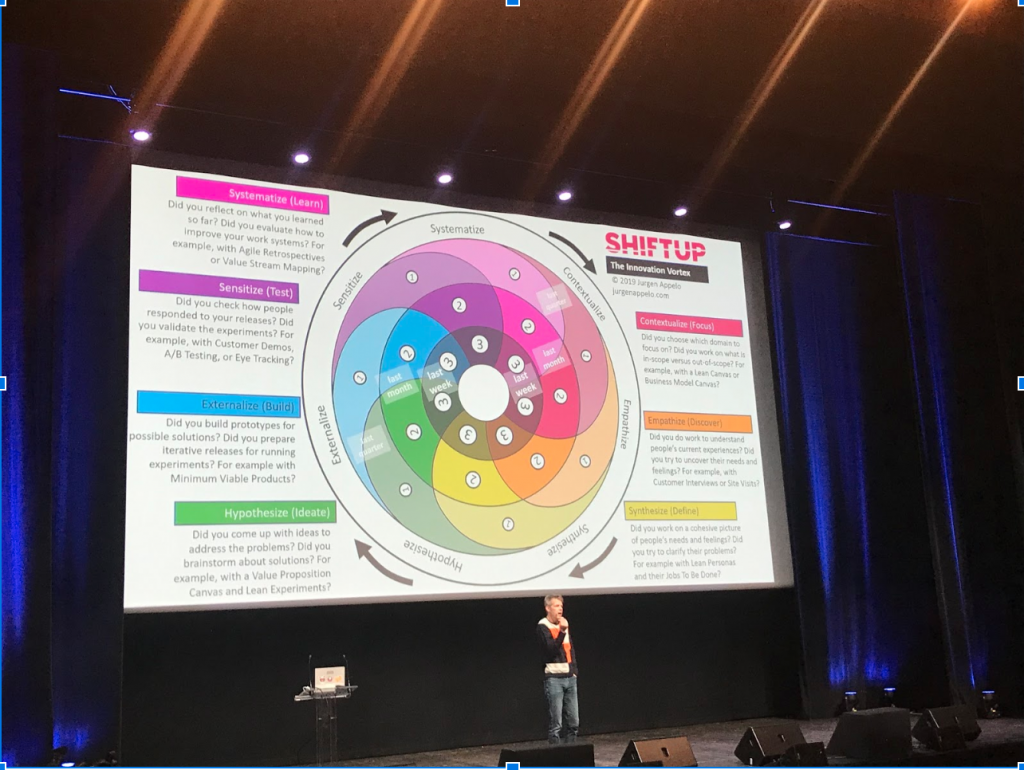
For example, he mentions the following tools and techniques to put in his vortex as an entrepreneur, designer, product manager or team:
- north star
- OKR's
- Ethnographic research, GOOB (Lean startup Go Out Of the Building)
- job to be done
- Value proposition canvas
- Backlog
- User journey or experience map
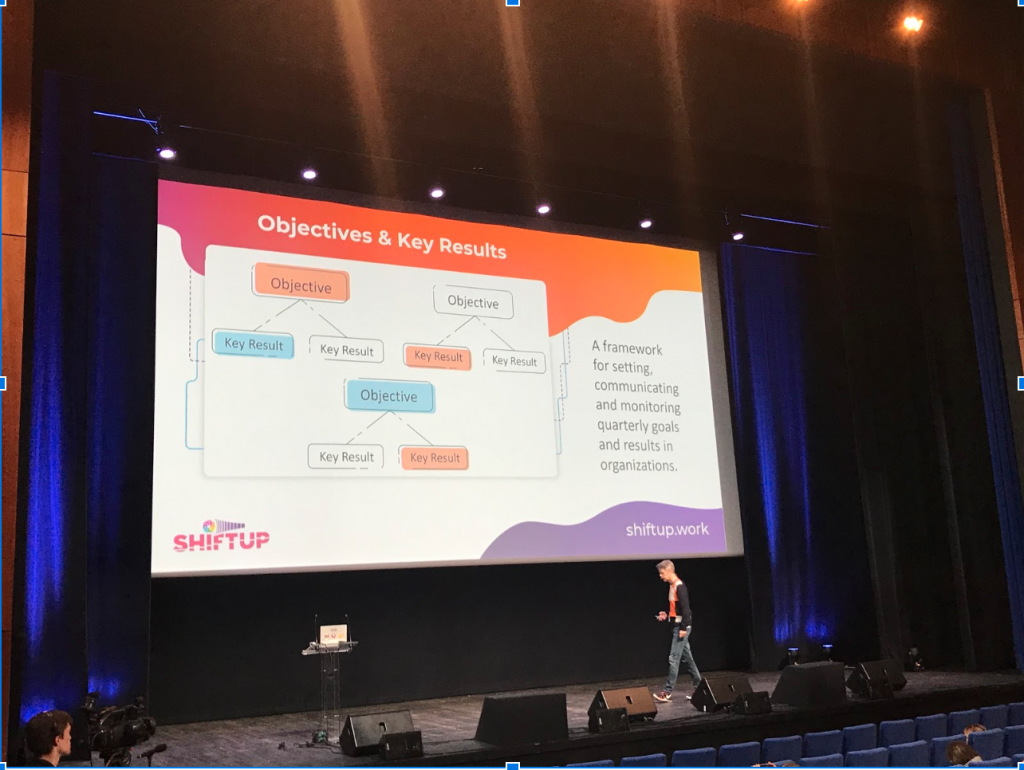
He points out that it is a mistake to see the creation and production of a product as something that must be done phase by phase, however this phase by phase process applies elsewhere, it applies to the life cycle. of the product on the market.
Here are the steps it defines :
- Initiation, beginning, the starting idea.
- Make sure that the solution we provide responds to a problem (problem/solution fit).
- Find a founder, investors who are in line with the vision (vision/founder fit).
- Ensure that people are ready to consume our product (product/market fit).
- stabilization
- acceleration
- Crystallization
- Expansion
- Conservation
- End
This article explains this more fully: https://shiftup.work/the-10-stages-of-the-business-lifecycle/ and you will be able to see the photos of his mom that he put at each step, amazing parallel, which I nevertheless found of the greatest effect.
Definitely one of my favorite presentations of these two days of conference.
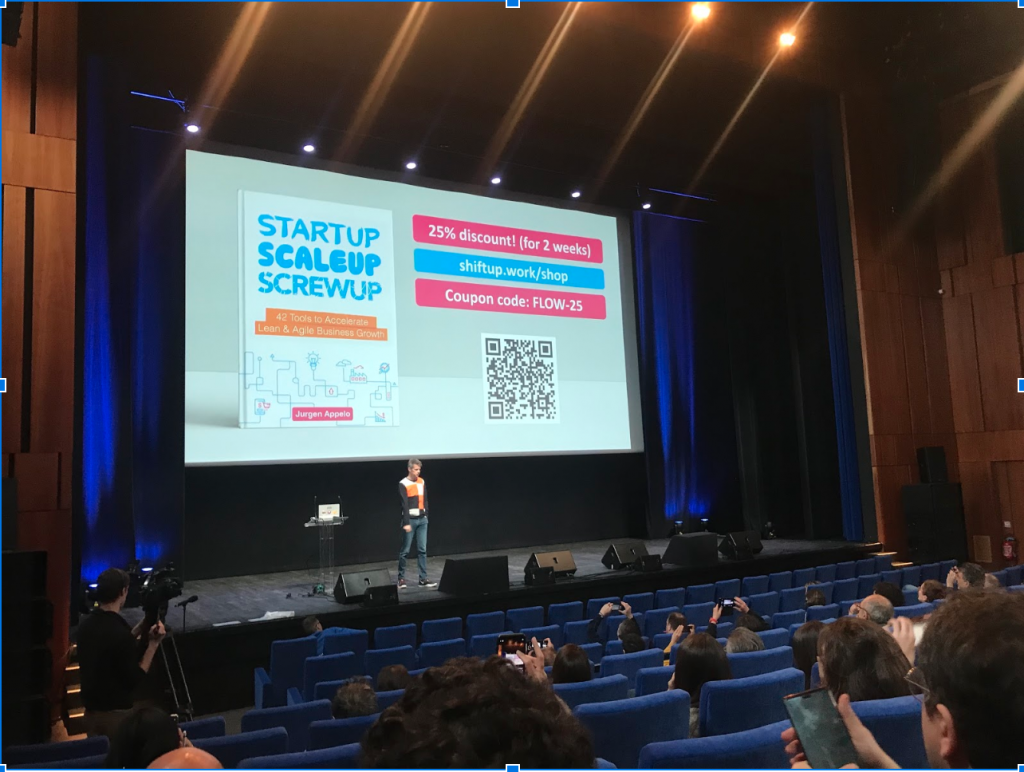
#3 Scaling up a tech department @ Younited Credit – Nicolas Nallet, Nicholas Suter
Youunited credit is a French company specializing in consumer credit. It is the first online credit platform for individuals in France that has been approved as a credit institution by the Prudential Control and Resolution Authority.
They know a hyper growth over the last three years with more than 40% increase in turnover.
They had 10 people in 2014 and 90 people in 2019.
In 2014 younited credit was present only in France, today their product is available in five countries and the company is a partner with major players such as free, N26, bpifrance.
Nicolas and Nicholas told us about their adventure as technical leads in the face of this hypergrowth. They chose an analogy with Star Wars to offer us a theory on the management of a spaceship (the tech department) which seeks to achieve demanding goals (8 weeks to set up everything that a new partnership with free entails), while being put in danger by the vagaries of life (dental appointments of productive team members, for example).
Their theory is based on the following analysis: the organization is a living organism, constantly changing, so we won't be able to stay on the straight line drawn between the ship and the objective.
I heard several times during this day the acronym VUCA (Volatile, Uncertain, Complex and Ambiguous).
Change is an "invariant" that must be integrated into the culture.
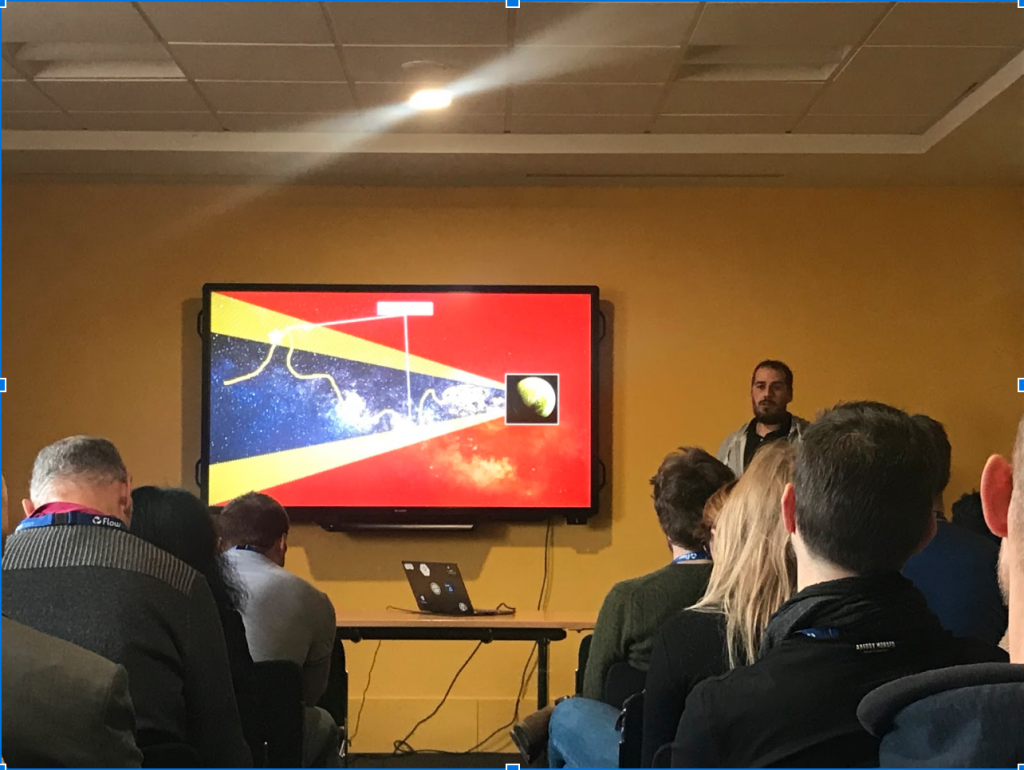
What they call “countermeasures” are what allow the crew to continue to control the trajectory of the ship and ensure that it does not end up in the “game-over” zone ( too deviant from this straight line towards the goal). If, like me, the term “countermeasure” does not speak to you, it seems that it comes from the military field, probably also taken up in Star Wars!? An article to better understand.
To find these countermeasures, employees have time dedicated to reflection and experimentation. Every Friday afternoon they get together and look for solutions to problems, Nicholas reminds us that engineers are brilliant people trained to solve complex problems, so they don't like to stupidly apply solutions. Keep in mind!
A quote from the pretty words of dear Nicholas Suter: “Simplicity is beautiful. But it is not necessarily easy to find a simple solution”.
Countermeasures have a cost and should not be implemented too late. In addition, the countermeasure is a voluntary action measure that requires an alert. These alerts require finding the right threshold, and this is not easy. Too drastic responses should be avoided, but an alert that is too fine-grained does not work either, as soon as the alert is sounded, it is already too late to find a solution.
What it takes for the crew to reach the objective in time :
1- have the right crew,
2- distribute decision-making power,
3- make communication more fluid,
4- Replace the leader with a “serving leader",
5- Find and execute countermeasures locally,
6- Leave room for error (without error being the goal, with honesty and transparency),
7- be transparent at all levels (at younited credit the executive committee publishes minutes of their meetings),
8- Introspect, set up regular feedback
to summarize :
- An elusive goal, an unpredictable living organization.
- Implement countermeasures triggered by alerts with the right threshold.
- Employees who have time to think about countermeasures and good agile management practices to provide a framework.
Thank you Nicolas and Nicholas for this instructive and pleasant moment!
#4 Professional and agile coaching a global approach to transformation – Claude Camus, Basile du Plessis
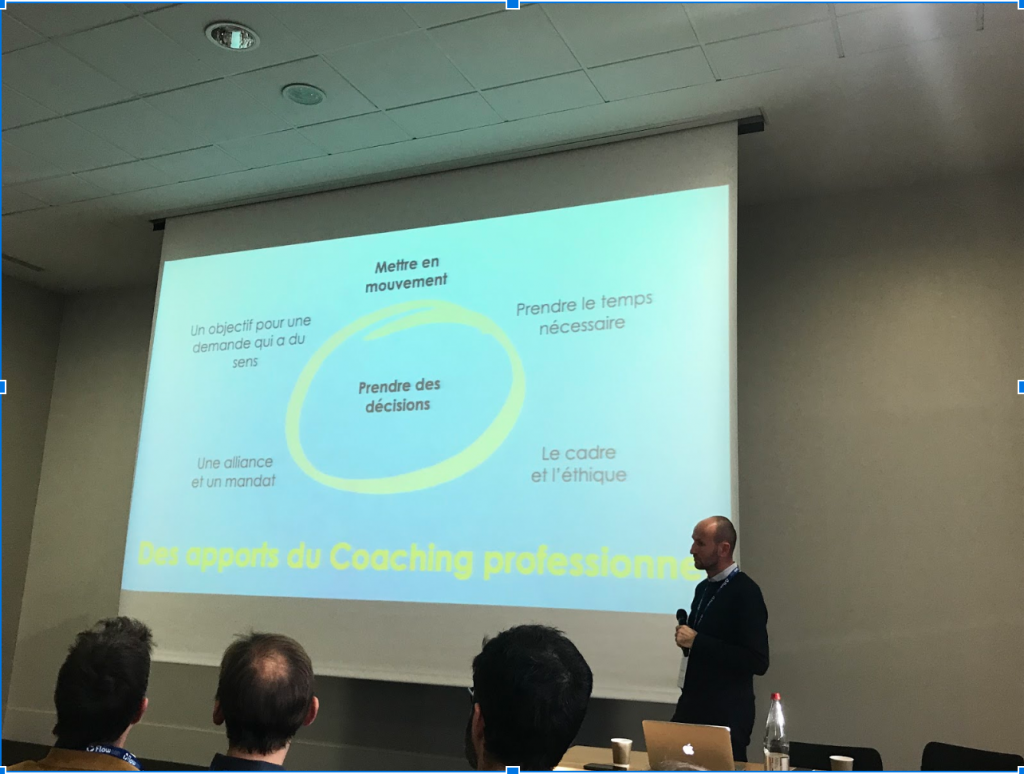
The first thing that seems to me to be understood is that it is important to “professionalize the profession” of agile coaching. A number of agile coaches are self-taught, to ensure they have the right posture, skills, qualities, etc. There are a number of things to keep in mind:
- Protocol,
- Mastery,
- Improvement,
- Commitment.
What a coach must ensure when he arrives on a new “mission” :
- Don't improvise, Reproducing makes it possible to improve, coaches who improvise can more difficultly improve their practices.
- Make sure todeal with the right people for their decisions to be implemented.
- Find the right time, the right time frame, move forward gradually and incrementally.
- The coach must to feel like a co-actor change, he is empowered.
- The establishment of a Organisation and more agile processes is not an end in itself, we must then support people.
The restructuring of an organization (company, administration, association, etc.) will generate uncomfortable situations :
- People who are not used to talking to each other need to work together.
- People will find themselves on the front of the stage without having held a position of responsibility before.
It is important tosupport employees :
- Legitimize the right people.
- Explain to them what their missions and responsibilities are.
- Give them a framework, limits.
- Judge on the result rather than on the intention and the plan, in order to be able to make decisions of the type “we continue” or “we stop”.
A few keys to coaching :
- Coaching is an art of accompaniment, it's like a pianist who needs to maintain and continually work on his skills.
- We keep in mind the follow-up of the objectives.
Here is a list of things to avoid for agile coaching to work :
- HR is not involved or not informed.
- Managers bias goals.
- The coach supports actions outside the framework of transformation.
- The team's agile coach is the manager's or the team member's pro coach, it's a conflict of interest.
- Accompany an individual and his n+1 and use what one says for the coaching of the other.
- The coach does not have a professional, recognized and certified supervisor (“we can touch deep things as a coach, the coach also needs to be accompanied”).
Ethics and limits” for the coach :
- He must be in continuous training.
- It must be ethical.
- It ensures data security.
Confirmed UX designers can find themselves in coaching situations or to make recommendations that challenge the organization. I therefore think that this presentation can provide us with areas for reflection and good practices to use on a daily basis.
#5 Liberating structures (workshop) – Gaël Mareau
I attended the workshop on liberating structures by Gael Mareau. We were about twenty people in the room and we did three exercises:
- 1-2-4 all,
- TRIZ,
- Crowd-sourcing.
What I think of reusing :
- The resource, I will look at the other “liberating structures” and see which ones interest me.
- The format of 1-2-4 all on large groups can facilitate exchanges.
- The benevolence and calm of the facilitator.
Note :
- The exercises that we carried out were not very relevant for decision-making and the definition of actions to be taken, they were more useful for opening a discussion and formulating many ideas.
- Crowdsourcing shows how to detect membership but not find the best solution.
The workshops being mainly oral exchanges, there were spontaneously speaking imbalances between people with different personalities.
I therefore come away with new things to explore, ideas and experiments to carry out to see at what stages to use these tools, how to dispassionate them and draw from them each time. an action plan for the future.
Only yours,
Anne Pedro, UX Designer @UXRepublic
UX/UI ECO-DESIGN # Paris
SMILE Paris
163 quay of Doctor Dervaux 92600 Asnières-sur-Seine
DESIGN THINKING: CREATING INNOVATION # Belgium
UX-REPUBLIC Belgium
12 avenue de Broqueville - 1150 Woluwe-Saint-Pierre
MANAGING AND MEASURING UX # Paris
SMILE Paris
163 quay of Doctor Dervaux 92600 Asnières-sur-Seine
DESIGN SPRINT: INITIATION & FACILITATION # Paris
SMILE Paris
163 quay of Doctor Dervaux 92600 Asnières-sur-Seine
UX-DESIGN: THE FUNDAMENTALS # Belgium
UX-REPUBLIC Belgium
12 avenue de Broqueville - 1150 Woluwe-Saint-Pierre
GOOGLE ANALYTICS 4 #Paris
SMILE Paris
163 quay of Doctor Dervaux 92600 Asnières-sur-Seine
ACCESSIBLE UX/UI DESIGN # Belgium
UX-REPUBLIC Belgium
12 avenue de Broqueville - 1150 Woluwe-Saint-Pierre
EXPERIENCE MAPPING # Paris
SMILE Paris
163 quay of Doctor Dervaux 92600 Asnières-sur-Seine
